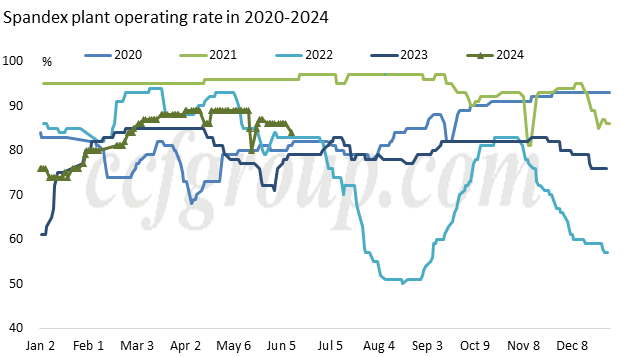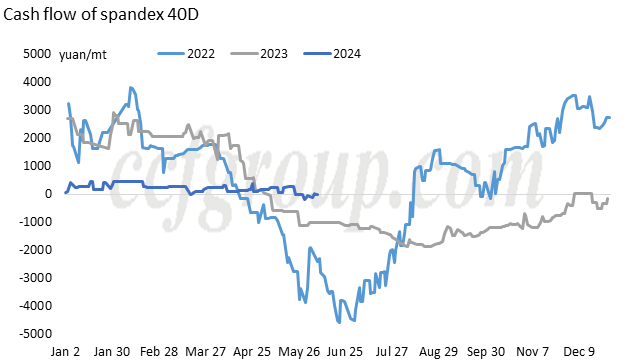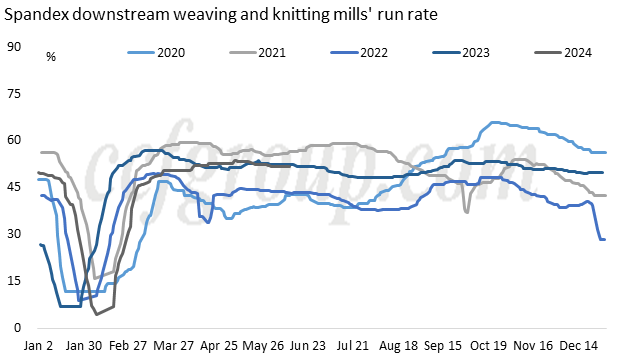Spandex burdened by weak fundamentals in short
After May, spandex industry has been operating at high levels, combined with the slow release of individual additional production capacity, resulting in a supply-demand gap for spandex suppliers. The supply of spandex industry is sufficient; however, downstream sectors are facing a switch in seasonal orders. Production of lightweight fabrics has decreased, while some autumn/winter fabric orders are insufficient. Samples and production of thicker fabrics mills are mainly accumulating inventory. The demand for spandex may seasonally decrease, adding pressure to the already imbalanced market in the short term.
Spandex supply adequate
As of early to mid-June, spandex production capacity in Chinese mainland is at 129.45 million tons/year. The average industry operating rate this year has been around 84.1%, which is close to the median level of the past five years. The operating rate has shown a trend of rising and falling (in below chart). As of the latest data, the industry run rate has decreased to 84%, with large enterprises (over 80,000 tons) at an average run rate of about 89%, while small and medium-sized spandex factories are at around 67%. Spandex suppliers' inventories have increased to around 50 days, with excess inventory of some brands at around 2 months and some lower ones at 30-40 days. Despite the inventory days being a medium-to-high level, with the expansion of spandex capacity, the inventory in case of total volume is at historically high, leading to significant delivery pressures.

Cash flow: continuous compression due to price decline
The price of spandex has been gradually declining since the beginning of the year. The price drop in April-May is more significant compared to February-March. Although raw material prices have also decreased with the release of additional capacity, the decline in spandex prices is slightly higher than that of raw materials. The cash flow of spandex 40D is gradually declining and is at a relatively low level in the first and second quarters of the year compared to the past three years.

Downstream: demand may gradually enter off-season
Currently, the operating levels of downstream weaving and knitting mills are above-historical-average levels. With spandex prices reaching historic lows, it is gradually penetrating the downstream textile and apparel sectors, still supported by essential demand. However, future demand may seasonally decline due to factors such as delayed order follow-ups by some weaving and knitting factories and high temperatures. The demand for spandex may not be as strong as in May. Currently, downstream run rates for various regions are at different levels, indicating varied demand patterns in different segments.

Note: The operating rate is average of covered yarn in Zhejiang and Jiangsu, circular knitting in Zhejiang and Jiangsu and Guangdong, lace in Fujian, warp knitting in Guangdong and core-spun yarn in Zhangjiagang.
Since the beginning of 2024, China's textile and clothing exports have seen some improvement compared to the second half of last year, but enterprises still face significant export trade pressures. The export rebound may be attributed to short-term factors such as seasonal changes and retail inventory replenishment. According to customs data, in the first five months of this year, China's textile and clothing exports amounted to $115.84 billion, a year-on-year increase of 1.4%; textile exports reached $57.13 billion, a year-on-year increase of 2.6%; and clothing exports totaled $58.72 billion, a marginal increase of 0.2%. In terms of domestic sales, compared to the high base of last year, the year-on-year growth rate has significantly slowed down. From January to April this year, the retail value of clothing, footwear, hats, needles, and textile products in national designated retail units was 471.69 billion yuan, with a cumulative year-on-year growth of 1.5%; the retail value of clothing products in national designated retail units amounted to 346.87 billion yuan, with a cumulative year-on-year growth of 1%.
Outlook
Spandex supply is relatively abundant in China, with plant operating rates still high. Inventories are at elevated levels. As the off-season approaches downstream, a further decline in operating levels in most sectors is likely. Spandex suppliers may see a slow increase in inventory due to the gap between production and sales, along with weak fundamentals in terms of supply and demand and costs. Downstream pressures are expected to increase gradually, leading to a continued downward adjustment in spandex prices at lower levels. Bidding competition among some brands still exists. Monitoring spandex factory shutdowns and new downstream order placements is crucial in the coming days.
- Top keywords
- Cotton Price
- Cotton Futures Price
- Cotton Futures
- CZCE
- PTA Futures Price
- Chemical Fiber
- Polyester Prices
- Wool price
- PTA Futures
- Shengze Silk
- China
- Yarn Price
- price
- China Textile City
- Fibre Price
- Benzene Price
- Cotton
- Index
- Cotton Index
- PTA
- fabric price
- NYMEX
- Top 10
- textile industry
- Spot Cotton
- Cotton Yarn
- Polyester Price
- Futures
- PTA Price
- cotton yarn price

